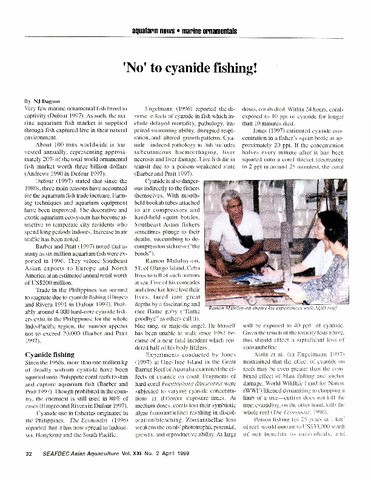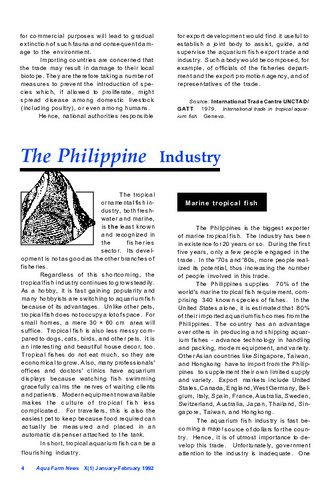Characterization of betanodaviruses in the Philippines
| dc.contributor.author | de la Peña, Leobert D. | |
| dc.contributor.author | Mori, K. | |
| dc.contributor.author | Quinitio, Gerald F. | |
| dc.contributor.author | Chavez, Denny S. | |
| dc.contributor.author | Toledo, Joebert D. | |
| dc.contributor.author | Suarnaba, Vonnie S. | |
| dc.contributor.author | Maeno, Y. | |
| dc.contributor.author | Kiryu, I. | |
| dc.contributor.author | Nakai, T. | |
| dc.date.accessioned | 2014-05-22T05:40:30Z | |
| dc.date.available | 2014-05-22T05:40:30Z | |
| dc.date.issued | 2008 | |
| dc.identifier.citation | de la Peña, L. D., Mori, K., Quinitio, G. F., Chavez, D. S., Toledo, J. D., Suarnaba, V. S., … Nakai, T. (2008). Characterization of betanodaviruses in the Philippines. Bulletin of the European Association of Fish Pathologists, 28(6), 230-237. | en |
| dc.identifier.issn | 0108-0288 | |
| dc.identifier.uri | http://hdl.handle.net/10862/2076 | |
| dc.description.abstract | Viral nervous necrosis caused by betanodaviruses is one of the most devastating diseases in cultured marine finfish. In the Philippines, mass mortalities occurred in sea bass, Lates calcarifer larvae and grouper, Epinephelus coioides broodstock. The virus was isolated using SSN-1 fish cell line and confirmed by PCR. Cytopathic effect started to develop in the cell line 2 days post infection (p.i) with tissue filtrates until the cells completely disintegrated and detached from the flask at 5 days p.i. and the viral protein was detected by immunofluorescence. Sequence analysis revealed that VNN isolated from the brain of grouper broodstock and sea bass larvae were 98.6% similar. Sequence analysis between the Philippine isolates and red-spotted grouper nervous necrosis virus (RGNNV) genotype is 96.9% similar as compared to 72.0% and 64.0% similar with the barfin flounder nervous necrosis virus (BFNNV) and tiger puffer nervous necrosis virus (TPNNV) genotypes, respectively. These results confirm that the Philippine isolates belong to RGNNV genotype. | en |
| dc.description.sponsorship | The study was funded by the Government of Japan Trust Fund to SEAFDEC AQD under the study code 8001-T-FD-FH1104. Thanks are due to Y. Inui, K. Nagasawa, K. Okuzawa and H. Ogata, fish disease experts/trust fund co-manager for their guidance and to M. Peniero, R. Traviña, M. Paner and G. Capulos for their technical assistance. | en |
| dc.language.iso | en | en |
| dc.publisher | European Association of Fish Pathologists | en |
| dc.relation.uri | https://eafp.org/download/2008-Volume28/Issue%206/28_230.pdf | |
| dc.subject | Dicentrarchus labrax | en |
| dc.subject | Pleuronectiformes | en |
| dc.subject | Lates calcarifer | en |
| dc.subject | Epinephelus coioides | en |
| dc.subject | Philippines, Panay I., Iloilo | en |
| dc.title | Characterization of betanodaviruses in the Philippines | en |
| dc.type | Article | en |
| dc.citation.volume | 28 | |
| dc.citation.issue | 6 | |
| dc.citation.spage | 230 | |
| dc.citation.epage | 237 | |
| dc.citation.journalTitle | Bulletin of the European Association of Fish Pathologists | en |
| dc.subject.asfa | catadromous fishes | en |
| dc.subject.asfa | brain | en |
| dc.subject.asfa | immunofluorescence | en |
| dc.subject.asfa | genotypes | en |
| dc.subject.asfa | fish larvae | en |
| dc.subject.asfa | nucleotides | en |
| dc.subject.asfa | marine fish | en |
| dc.subject.asfa | nervous system | en |
| dc.subject.asfa | viral diseases | en |
| dc.subject.asfa | RNA | en |
| dc.subject.asfa | necrosis | en |
| dc.subject.asfa | polymerase chain reaction | en |
| dc.subject.asfa | mariculture | en |
| dc.subject.asfa | breeding stock | en |
| dc.subject.asfa | fish culture | en |
| dc.subject.scientificName | Lates calcarifer | en |
このアイテムのファイル
| ファイル | サイズ | フォーマット | 閲覧 |
|---|---|---|---|
|
このアイテムに関連するファイルは存在しません。 |
|||
このアイテムは次のコレクションに所属しています
-
Journal Articles [1258]
These papers were contributed by Department staff to various national and international journals.




